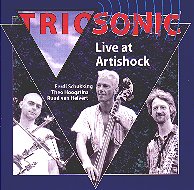Back to index Triosonic | Back
to "About Triosonic"

"Live at Artishock". Recorded Live in Artishock Theatre,
Soest, 14 June, 1997.
Ferdi Schukking (saxophones), Theo
Hoogstins (double bass),
Ruud van Helvert (drums)
-
Visserstraat Blues (Fisherstreet Blues) is a blueslick
played by the bass, which evolves into a 3/4 time. During the improvisation,
the 3/4 time can be played at any given spot. The 14 bar structure
turns the fours with the drums into an exciting climax.
-
444 & 453 is a ballad with the melody consisting of all
twelve tones. The numbers refer to the use of complementary tetrachords,
which are comparable to the harmolodics of Ornette Coleman. The 453
stands for a tetrachord, a pentachord and a very surprising e-minor
triad at the end of the theme.
- Multiphonics/Vogelvlucht. One can play multiphonics
on a saxophone too. With certain grip combinations and an extremely
flexible embouchure, even chords can be brought to sound. Multiphonics
is being played on the soprano saxophone; quietly, chromatic, modulating,
and further back in the beginning. Then, more violent, with dissonants,
shrill-and-high further on. Vogelvlucht-(Bird's-eye View), the second
part, suggests additional tones by the rapid arpeggio movement. The
"circular-breathing-technique" also amplifies this effect.
- 7th Hour Blues. By projecting a twelvetone series,
based on the "seventh hour" of Peter Schat's Tone Clock
©, on a minor blues, an unusual melody occurs, with only the
last tone defining the key. The baritone saxophone and the bass alternate
the solo, and accompany the drum solo with rhythmic background patterns.
- Wind in Rockanje originated during a performance at
the Dutch seaside resort of Rockanje. The murmur of the sea is heard
in the false air of the tenor saxophone. The water coarses through
the two chords of the bass, suggesting a gathering storm.
- Octocon (Octotonic construction) is a composition
based on two octotonic scales which are worked up into series according
to the applications of Arnold Schoenberg. By harmonising these into
two dominant seventh chords, a fanciful reference to the blues occurs.
- Spiral Sequence is a twelve-tone series, which, because
of rhythmic variation, takes on a different character each time it
is repeated. The series played in reverse order introduce the solos,
and the improvisations are based on the series and the variations.
 0
Amor Natural is a composition inspired by Hedy Honingmann's
Dutch television documentary about the Brazilian poet Carlos Drummond
de Andrade (1902-1987), who began writing erotic poetry in his late
years. In the documentary, the poems are recited by contemporaries
of the same age as de Andrade, and afterwards the readers are encouraged
to interact with the text they have just read. This results in an
overview of the age of lovemaking, with all its humour, tenderness,
and deeply intimate and touching moments, but also with a certain
capriciousness and heedlessness of the human existence. All of these
elements are discernible in the composition. The ongoing 6/8 movement,
the lyrical melody, and with fervent improvisations. 0
Amor Natural is a composition inspired by Hedy Honingmann's
Dutch television documentary about the Brazilian poet Carlos Drummond
de Andrade (1902-1987), who began writing erotic poetry in his late
years. In the documentary, the poems are recited by contemporaries
of the same age as de Andrade, and afterwards the readers are encouraged
to interact with the text they have just read. This results in an
overview of the age of lovemaking, with all its humour, tenderness,
and deeply intimate and touching moments, but also with a certain
capriciousness and heedlessness of the human existence. All of these
elements are discernible in the composition. The ongoing 6/8 movement,
the lyrical melody, and with fervent improvisations.
-
Klipzo
is a lively melody, based on the Caribbean Calypso. In the bridge
the theme is being played half-a-tone higher and shifted one beat
(the beat is reversed). And the count is seven bars instead of eight.
|

